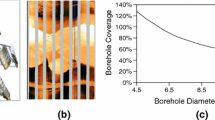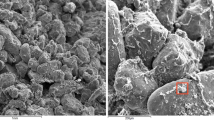Abstract
Borehole image logs are produced by tools lowered into a well. Such logs provide oriented electrical and acoustic maps of rocks and fluids encountered in the borehole. Electrical borehole images, acquired in either water-based (conductive) or oil-based (nonconductive) muds, are generated from electrodes arranged in fixed patterns on pads pressed against the borehole wall. Depending on borehole diameter, gaps nearly always occur between pads. Because of these gaps, it is common to have nonimaged parts of the borehole wall. The existence of gaps in pad-based borehole images hinders efficient geological interpretation and accurate formation evaluation. A novel method to generate fullbore images combines an inpainting technique with FilterSim: a continuous-variable multipoint statistical approach. The inpainting algorithm detects dips and captures the trend of borehole image logs. The extracted smooth trend maps are fed into FilterSim to guide the construction of high-resolution textures that honor the original borehole image data, leading to seamless reconstruction of 360\(^{\circ }\) fullbore images. The proposed method has been tested using various borehole image patterns and proves to be a reliable and robust way to perform fullbore image reconstruction. The reconstructed fullbore images facilitate improved visualization and interpretation of borehole image logs in various ways, including automated dip picking for fractures and bedding planes, thin-bed analysis in deepwater formations, complex heterogeneity analysis, and accurate porosity estimation in carbonates.


















Similar content being viewed by others
References
Assous S, Whetton J, Elkington PA (2013) Microresistivity image inpainting and visualization. doi:10.2118/166106-MS
Bertalmío M, Sapiro G, Caselles V, Ballester C (2000) Image inpainting. In: Proceedings of ACM SIGGRAPH conference on computer graphics, New Orleans, pp 417–424
Gilreath JA (1987) Strategies for dipmeter interpretation: part I. Tech Rev 35:28–41
Guardiano F, Srivastava RM (1993) Multivariate geostatistics: beyond bivariate moments. In: Soares A (ed) Geostatistics-troia, vol 1. Kluwer Academic Publications, Dordrecht, pp 133–144
Hurley N, Zhang T (2011) Method to generate fullbore images using borehole images and multi-point statistics. SPE Res Eval Eng 14:204–214. doi:10.2118/120671-MS
Mariethoz G, Renard P (2010) Reconstruction of incomplete data sets or images using direct sampling. Math Geosci 42:245–268. doi:10.1007/s11004-010-9270-0
Mustapha M, Dimitrakopoulos R (2010) High-order stochastic simulation of complex spatially distributed natural phenomena. Math Geol 42:457–485. doi:10.1007/s11004-010-9291-8
Strebelle S (2002) Conditional simulation of complex geological structures using multiple point statistics. Math Geol 34(1):1–22. doi:10.1023/A:1014009426274
Takeda H, Farsiu S, Milanfar P (2007) Kernel regression for imaging processing and reconstruction. IEEE Trans Image Process 16:349–366. doi:10.1109/tip2006888330
Yamada T, Quesada D, Etchecopar A, Le Nir I, Delhomme J, Houston J, Perdana T (2013) Revisiting porosity analysis from electricalborehole images: integration of advanced texture and porosity analysis. In: SPWLA 54th annual logging symposium
Zhang T (2006) Filter-based training image pattern classification for spatial pattern simulation. Dissertation, Stanford University
Zhang T, Switzer P, Journel A (2006) Filter-based classification of training image patterns for spatial simulation. Math Geol 38(1):63–80. doi:10.1007/s11004-005-9004-x
Acknowledgments
We would like to thank Schlumberger for the permission to publish this work. Thanks to Sergey Egorov, Weixin Xu, and Roger Griffiths for providing the case study data set. We thank Josselin Kherroubi, Daniel Quasada, and Isabelle Le Nir for helpful technical discussions, testing, and engineering of the proposed fullbore reconstruction techniques and workflow.
Author information
Authors and Affiliations
Corresponding author
Rights and permissions
About this article
Cite this article
Zhang, T., Gelman, A. & Laronga, R. Structure- and Texture-Based Fullbore Image Reconstruction. Math Geosci 49, 195–215 (2017). https://doi.org/10.1007/s11004-016-9649-7
Received:
Accepted:
Published:
Issue Date:
DOI: https://doi.org/10.1007/s11004-016-9649-7




